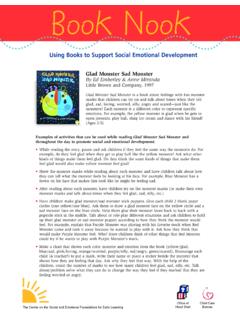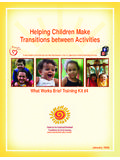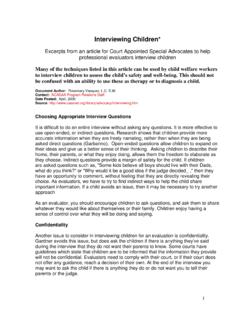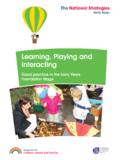Transcription of Playing With Children - Feldenkrais Institute
1 January/February 2013 $ Playing with Children plus: Managing Pain with Opioids Feldenkrais Method . Moving More Easily Sorting Out Supplements For subscription information, please call (800) 234-0923. Or for a Free Trial Issue, visit us on the Web at Reprinted with permission from Arthritis Self-Management, January/February 2013. Copyright 2013 Rapaport Publishing, Inc. THE. Feldenkrais . METHOD. Stress-Free Exercise for People with Arthritis by David Zemach-Bersin and Mark Hirschfield the Feldenkrais Method can undo many of the aches and pains that plague us, and I currently recommend it to patients whose movement has been restricted by injury or chronic pain.
2 I also believe the Feldenkrais Method can help older people achieve greater range of motion and flexibility, and help all of us feel more comfortable in our bodies.. Andrew Weil, MD. M Safe, easy exercise any people with arthritis find it chal- lenging to get enough exercise. You know that it is important, and you The Feldenkrais Method bears little resemblance know that you've got to keep moving to conventional forms of exercise and works on to maintain joint health. But as much as you might entirely different principles. It improves the way like to run a marathon, the fact is, many physical in which the brain coordinates posture and move- activities cause discomfort.
3 How can you enjoy ment. By engaging the brain's ability to relearn doing something that exacerbates your arthritis and change, the Feldenkrais method improves the symptoms instead of making them better? exchange of relevant information between the ner- The Feldenkrais Method is a sophisticated form of vous system and the muscles, and as a result, move- sensory-motor education, which interacts with the ment becomes more comfortable. Although Felden- brain in a special way to improve the comfort and krais exercises are not aerobic, they provide many function of the body. It may be of special interest to of the benefits commonly associated with exercise, people with arthritis because it is so different from including increased production of the synovial fluid other forms of exercise.
4 While conventional exercise that acts as a lubricant inside your joints, increased typically involves the repetition of strenuous move- flexibility, better circulation, improved respiratory ments, the Feldenkrais Method takes a very different function, better coordination and balance, and an approach. Feldenkrais exercises involve no stretch- overall sense of well-being. For people with arthritis, ing or straining and require only minimal muscular the Feldenkrais Method can help to reduce friction, effort. They use slow, easy-to-do movements that are swelling, and inflammation in the joints, and can designed to engage the brain's ability to change in interrupt cycles of pain and tension.
5 In addition, response to stimulus (its neuroplasticity) to improve once a person is able to move more comfortably, the body's underlying neuromuscular and skeletal he may be able to start engaging in more strenuous organization. aerobic or strength-building exercises. January/February 2013 15. A SHORT Feldenkrais EXERCISE. Try this short Feldenkrais exercise to improve your reaching, and bending. By improving your ability ody s ability to turn comfortably and easily body's easily. The to turn, you can improve your body's comfort and sults of doing this simple exercise may surprise results su function in a wide range of situations.
6 U, as turning is an important aspect of almost you, a When you do a Feldenkrais exercise, it is impor- ery movement you make, including wa every walking, tant to remember the following: 2. Focus your eyes on an object or spot straight ahead of you. While your eyes continue to look at the spot or object, slowly turn your head and upper body a little bit to the right. Then slowly return to facing forward and pause. Repeat this movement 6 10 times. Don't stretch or strain, use force, or turn farther than is truly comfortable. Notice how keeping your eyes fixed restricts your turning. Relax your neck, jaw, shoulders, chest, abdomen, and legs.
7 1. Sitting on the forward edge of a chair with a flat seat, slowly turn your upper body, as if to look to the right a little bit. Then return slowly to 3. Do movement #1 again: Slowly turn your upper face forward and rest for a moment before doing body, as if to look to the right. Then slowly return the movement again. Keep your feet flat on the to facing forward and rest. Repeat this movement floor, and repeat this movement 6 10 times. Notice 2 4 times. Is there any improvement in your ease exactly how far to the right you can see easily, of movement as you turn? Can you see a little far- without feeling any strain. ther to the right?
8 Rest in the middle, and notice whether your left shoulder and the left side of your neck feel more relaxed. 16 Arthritis Self-Management Do each movement in a way that is easy and Relax and exhale as you do each movement. comfortable. Do not stretch or strain. Use as little muscular effort as possible. Rest between each movement. Do each movement slowly. Make each movement small. 6. Keeping your feet flat on the floor, simply move your left knee forward slightly. Repeat this move- ment very slowly 6 10 times. After each movement, let your knee return to the starting position and rest. Relax your leg and reduce any unnecessary muscular effort.
9 Notice how your left buttock and hip move forward a little. Feel how your head, eyes, and shoulders turn slightly to the right as the left knee moves forward. 4. Now do the movement again, but keep both your head and eyes facing forward. Repeat this movement very slowly 6 10 times. As you turn, notice how your left shoulder moves forward, and your right shoulder moves back. Relax your face, neck, shoulders, and stomach. Try to reduce any unnecessary muscular effort. 5. Do movement #1 again: Slowly turn your upper body, as if to look to the right. Then slowly return to facing forward and rest. Repeat this movement 2 4 times.
10 Is there any improvement in your ease of movement as you turn? Can you see a little far- ther to the right? Rest a moment and notice: Does your left side feel more relaxed than your right side? January/February 2013 17. In a study done with 21 people with rheumatoid 7. Move your left knee forward while turning your arthritis (RA) who engaged in a series of Feldenkrais head, eyes, and upper body to the right a little exercises, participants experienced both a signifi- bit. Repeat this movement very slowly 6 10 times. cant improvement in muscle activity and a decrease Reduce unnecessary muscular effort and notice in their perceived effort, or the amount of effort how your left hip moves forward as you turn.







